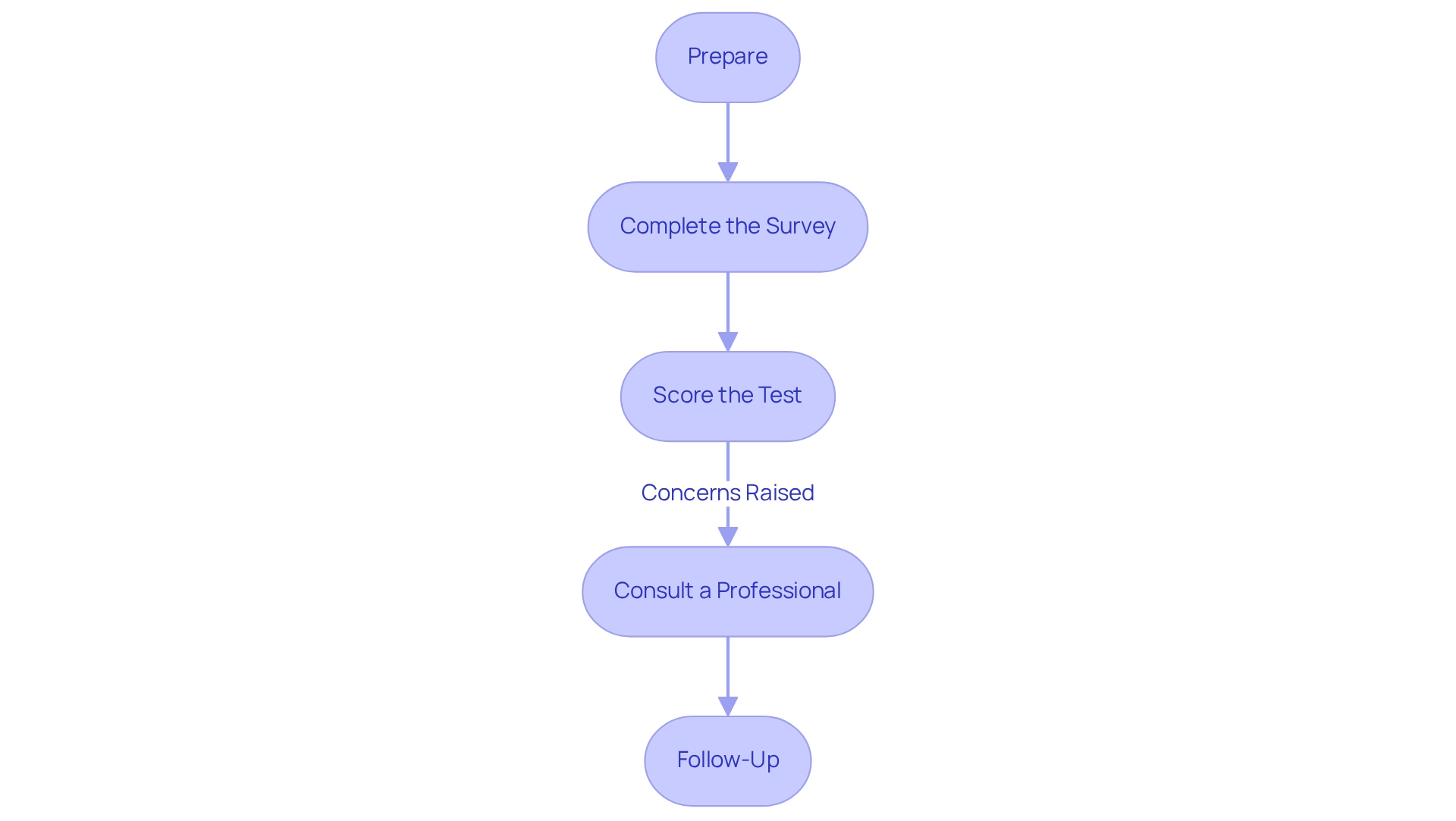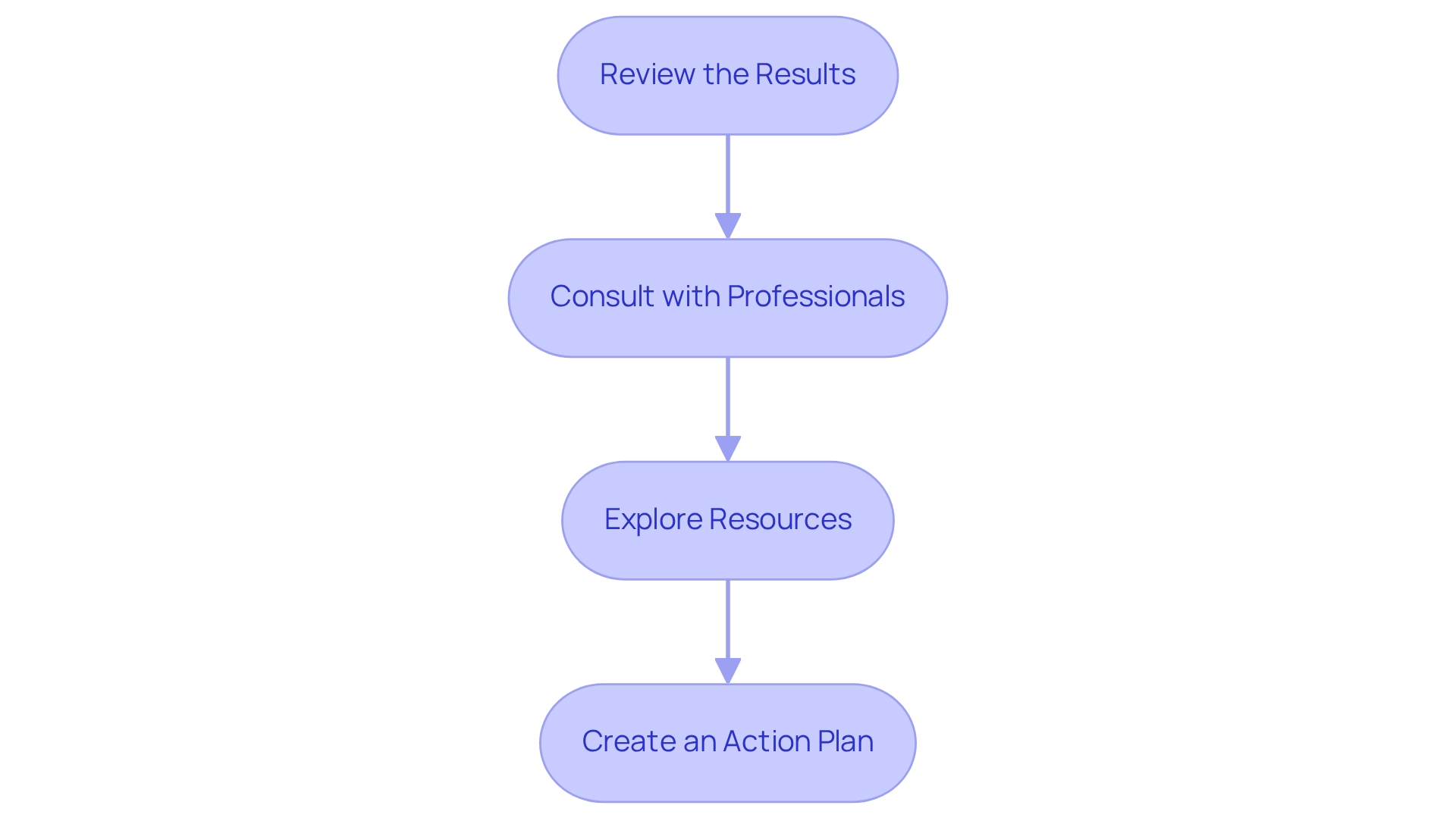Overview
Navigating an autism test for toddlers can feel overwhelming, but understanding the essential steps can make a significant difference. Timely identification of autism spectrum disorder (ASD) is crucial, as it opens the door to necessary interventions that can support your child's development.
Start by being aware of the signs to look for; knowing what to observe can empower you as a parent. Next, familiarize yourself with the Modified Checklist for Autism in Toddlers (M-CHAT-R). This tool is designed to help you assess your child's behavior effectively.
Interpreting the results is a vital step, and it’s important to seek professional guidance. A professional can help you create a tailored action plan that addresses your child's unique needs. Remember, you are not alone on this journey—support is available, and taking these steps can lead to positive outcomes for your child.
Introduction
Navigating the complexities of autism testing for toddlers can feel overwhelming for many parents. However, this journey is vital, as it holds the key to unlocking a brighter future for their children. Early identification of autism spectrum disorder (ASD) is crucial; it paves the way for timely interventions that can significantly enhance developmental outcomes. Research consistently highlights the benefits of early diagnosis, empowering parents to recognize the signs of autism and take proactive steps to ensure their child receives the necessary support.
This article explores the essential components of autism testing. From identifying key signs to selecting appropriate assessments and interpreting results, it serves as a comprehensive guide for caregivers eager to advocate for their child’s well-being.
Understand the Purpose of Autism Testing for Toddlers
Understanding the importance of an autism test toddler is essential for the timely identification of developmental delays and behavioral challenges. This evaluation, known as an autism test toddler, aims to determine whether a young child shows signs of autism spectrum disorder (ASD), which is vital for accessing necessary intervention services. Research highlights that conducting an autism test toddler can significantly enhance a child's development in critical areas such as communication, social skills, and behavior management. Notably, Applied Behavior Analysis (ABA) therapy often emerges as the first recommendation for families facing a developmental disorder diagnosis, underscoring its pivotal role in the intervention journey.
A recent public health report has revealed a concerning statistic: children diagnosed with developmental disorders at age four are more likely to experience intellectual disabilities compared to those diagnosed at age eight. This finding emphasizes the urgent need for timely assessments and equitable diagnostic services. Furthermore, surveys indicate that 36.5% of caregivers for children with developmental disorders utilize ABA therapy, with many reporting positive outcomes. This data underscores the effectiveness of early intervention strategies.
As parents, understanding the purpose of developmental assessments can empower you to approach the process with confidence and clarity. It is a proactive step toward ensuring your child's well-being and future success. Insights from the public health report titled "Public Health Action for ASD" advocate for improved planning and resources to provide equitable diagnostic and support services, ensuring that every child with ASD has the opportunity to reach their full potential. Let us work together to create a supportive environment for our children.
Identify Key Signs of Autism in Your Toddler
As parents, recognizing the early signs of autism in toddlers is crucial for fostering their development. Common indicators include:
- Limited eye contact
- A lack of response to their name
- Difficulty engaging in back-and-forth interactions, such as not responding to smiles or gestures
- Repetitive actions, like hand-flapping or spinning objects, which may capture their focus intensely, often to the exclusion of other activities
- Delayed speech or language skills, such as not using single words by 16 months
These signs warrant attention in relation to an autism test for toddlers. By being aware of these signs, you can closely monitor your child's development and seek professional guidance if you observe any troubling behaviors. Remember, you're not alone in this journey; many parents share similar experiences and concerns. It’s important to engage with your child, nurturing their growth and seeking support when needed. Together, we can create an environment that fosters understanding and compassion.
Select and Administer an Appropriate Autism Test
Choosing the right autism test toddler is crucial, and the Modified Checklist for Autism in Toddlers, Revised (M-CHAT-R) is an excellent option for children aged 16 to 30 months. This assessment tool includes 20 questions about your child's behaviors, designed to be completed by parents. Here’s a simple guide on how to effectively administer the M-CHAT-R:
- Prepare: Find a quiet, distraction-free space to help you focus on the questions.
- Finish the survey by responding to every question truthfully, reflecting on your child's behavior. This honesty is essential for accurate results.
- Score the Test: Once you’ve filled out the questionnaire, calculate your score according to the provided guidelines. A higher score may suggest the need for further evaluation.
- Consult a professional: If your results raise any concerns, it’s important to reach out to a pediatrician or a child development specialist for a thorough evaluation, particularly if you're considering an autism test toddler, as research shows that the M-CHAT-R is highly effective in identifying children who may require further assessment, with studies indicating it can detect developmental disorders in about 85% of cases when used properly. As O. Ivar Lovaas famously said, 'If they can't learn the way we teach, we teach the way they learn,' highlighting the importance of personalized approaches in understanding developmental differences. Additionally, one parent shared, 'I don’t always have all the answers, but I do have Google,' reflecting the journey many parents face in seeking information and support.
By following these steps, you can take a proactive approach to your child's developmental health. If your results suggest potential concerns, remember that the next step is to reach out to a professional who can offer further guidance and support.

Interpret Test Results and Plan Next Steps
Once you receive the results from the autism test, it's important to take thoughtful steps to interpret them and plan your next actions.
- Review the Results: Begin by understanding the score and what it indicates about your child's risk for autism. A high score on the autism test toddler may indicate that further evaluation is necessary, which can feel overwhelming, but you're not alone in this journey.
- Consult with Professionals: It's crucial to schedule a follow-up appointment with your pediatrician or a developmental specialist to discuss the results in detail. They can provide valuable insights into what the scores mean and recommend further assessments if needed, helping you feel more informed and supported.
- Explore Resources: Depending on the outcome, take the time to look into available resources, such as early intervention programs, support groups, and educational materials. These can play a vital role in aiding your child's development and ensuring they receive the support they need.
- Create an Action Plan: Collaborate with professionals to develop a tailored action plan that addresses your child's specific needs. This plan should include strategies for both home and school environments to foster their growth and learning, empowering you as a parent to advocate for your child effectively.

Conclusion
Understanding autism testing for toddlers is a vital step in ensuring that children receive the support they need at an early stage. This journey involves:
- Recognizing the purpose of testing
- Identifying key signs of autism
- Selecting appropriate assessments
- Interpreting the results effectively
By taking proactive steps, parents can facilitate timely interventions that significantly enhance their child's developmental trajectory.
The importance of early diagnosis cannot be overstated. Recognizing the signs of autism—such as limited eye contact or delayed speech—enables parents to seek professional guidance promptly. Tools like the Modified Checklist for Autism in Toddlers (M-CHAT-R) empower caregivers, providing them with the means to assess their child's behavior accurately. This leads to informed discussions with healthcare professionals, ensuring that no stone is left unturned in seeking the best for their child.
Ultimately, the core message is clear: early identification and intervention are essential for the well-being and future success of children with autism. By navigating the complexities of autism testing with knowledge and confidence, parents can advocate effectively for their child's needs. This advocacy ensures they receive the necessary resources and support to thrive. Taking these steps not only benefits the child but also empowers families to create a nurturing environment that fosters growth and development. Remember, you are not alone in this journey—together, we can make a difference.
Frequently Asked Questions
What is the purpose of an autism test for toddlers?
The purpose of an autism test for toddlers is to identify signs of autism spectrum disorder (ASD) early, which is essential for accessing necessary intervention services and addressing developmental delays and behavioral challenges.
How can an autism test for toddlers impact a child's development?
Conducting an autism test for toddlers can significantly enhance a child's development in critical areas such as communication, social skills, and behavior management.
What is the recommended intervention for families facing a developmental disorder diagnosis?
Applied Behavior Analysis (ABA) therapy is often recommended as the first intervention for families dealing with a developmental disorder diagnosis.
What does recent research indicate about the timing of developmental disorder diagnoses?
Recent research shows that children diagnosed with developmental disorders at age four are more likely to experience intellectual disabilities compared to those diagnosed at age eight, highlighting the need for timely assessments.
What percentage of caregivers utilize ABA therapy for children with developmental disorders?
Surveys indicate that 36.5% of caregivers for children with developmental disorders utilize ABA therapy, with many reporting positive outcomes.
How can parents approach the process of developmental assessments?
Parents can approach developmental assessments with confidence and clarity by understanding their purpose, which empowers them to take proactive steps for their child's well-being and future success.
What recommendations does the public health report titled "Public Health Action for ASD" make?
The report advocates for improved planning and resources to provide equitable diagnostic and support services, ensuring that every child with ASD has the opportunity to reach their full potential.




